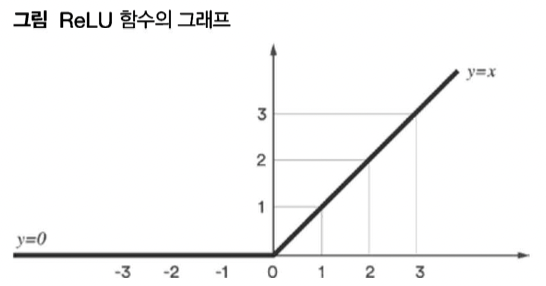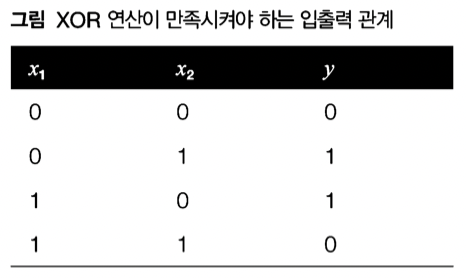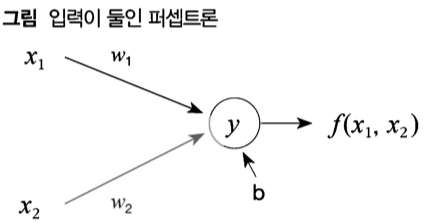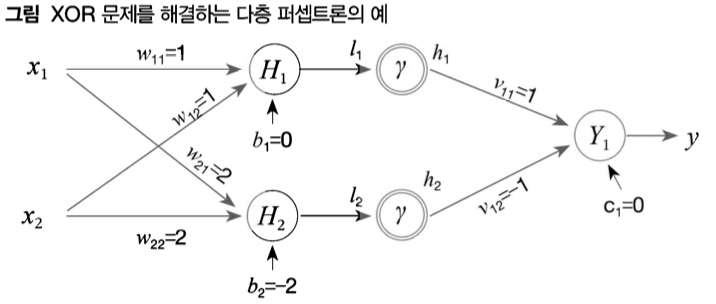
- 윤덕호 저서 파이썬 날코딩으로 알고 짜는 딥러닝을 공부하고 개인적으로 정리한 글입니다.
- 사진, 내용, 코드는 책을 참고한 것입니다. 코드는 오픈소스로 저저의 깃허브에 모두에게 공개되어있습니다.
- Ch1 - 단층퍼셉트론(SLP), Ch2 - 단층퍼셉트론(Sigmoid-이진판단), Ch3 - 단층퍼셉트론(Softmax-선택분류)의 코드를 수정 및 재활용 했습니다.
다층 퍼셉트론 신경망 구조

- 복수의 퍼셉트론 계층을 순서를 두고 배치하여, 중간 표현을 거쳐 출력 벡터를 얻어내는 신경망, 은닉 계층을 적어도 하나 이상 갖는 것이 보통
- 다층 퍼셉트론에서 각각의 계층은 단층 퍼셉트론과 같은 내부 구조
- 하나의 계층 내 퍼샙트론들은 동일한 입력을 공유하고 각각의 출력하고 인접한 계층끼리 앞 계층의 출력은 뒤 계층의 입력으로 제공됨, 인접 계층끼리는 완전 연결 방식
- 단층퍼셉트론은 0개의 은닉 계층을 갖는 다층 퍼셉트론의 특수한 경우라고 볼 수 있음
은닉 계층의 수와 폭
- 폭은 해당 계층이 갖는 퍼셉트론의 수이자 생성하는 은닉 벡터의 크기, 이 퍼셉트론을 노드라고 함
- 한 계층의 퍼셉트론들은 각각 해당 계층에 대한 입력 벡터 크기 만큼의 가중치와 편향 파라미터를 가짐
- 앞에 그림으로 제시된 신경망은 첫번째 은닉층 = 4 x 3 + 3 = 15, 두번째 은닉층 = 3 x 3 +3 = 12, 출력층은 3 x 4 + 4 = 16으로 총 43개의 파라미터를 갖음
- 은닉 계층을 추가해서 파라미터 수가 늘어나면 더 많은 학습 데이터가 필요해지는 경향이 있음
- 문제이 규모, 데이터양, 난이도를 종합적으로 고려해야 함, 따라서 은닉 계층 수와 폭 설정 값을 쉽게 바꾸어 실험할 수 있게 프로그램을 구현해야 함
비선형 활성화 함수
- 선형 연산 뒷단에 적용되어 퍼셉트론의 출력을 변형시키는 함수
- 일차 함수로 표현이 불가능한 좀 더 복잡한 기능을 수행 (ex) 시그모이드, 소프트맥스
- 출력 벡터를 구성하는 각 정보의 특성에 맞게 별도의 비선형 처리를 해야 하는데 출력 계층 안에 비선형 활성화 함수를 두면 코드가 지나치게 복잡해짐
- 출력 계층에는 비선형 활성화 함수가 사용되지 않는데 이 때문에 단층 퍼셉트론에서는 후처리 과정에서 비선형 함수를 사용하되 출력 계층 내부의 비선형 활성화 함수를 따로 다루지 않음
- 은닉 계층에서는 다음 은닉 계층, 출력 계층으로 입력하기 위해 비선형 함수가 사용됨
- 따라서 비선형 활성화 함수는 필수적 구성요소임, 선형 처리는 아무리 여러 단계를 반복해도 하나의 선형 처리로 줄여 표현할 수 있음(비선형 활성화가 없는 다층 퍼셉트론은 단층 퍼셉트론으로 만들 수 있음)
- 노드 수가 많은 단층 구조 신경망보다 노드 수가 적은 다층 구조 신경망 성능이 훨씬 우수한 경우가 많음 입력 데이터로부터 유용한 정보를 추출해내는 추상화에 다층구조가 더 효과적이기 때문, 딥러닝이 부각되계된 계기
ReLU 함수

- 음수 입력을 걸러내 0으로 만드는 함수, 은닉 계층의 비선형 활성화 함수로 가장 많이 이용됨
- 시그모이드나 소프트맥스는 복잡한 계산과정 때문에 처리 부담이 크며, 소프트 맥스는 벡터 원소들을 묶어 처리하기 때문에 은닉 계층 출력 처리에는 부적합함
- x = 0 에서 미분이 불가능한 것이 문제인데, 미분값을 0우로 강제 할당함, 별문제 없는 경우가 다수
- 이렇게 되면 미분 후 계산이 쉬워 지는데 양수이면 1로 음수이면 0 으로 출력됨 (numpy.sign(y) 사용 가능)
민스키의 XOR 문제와 비선형 활성화 함수
- 단층에서는 해결하지 못하는 문제


- 구조적으로 x와 y는 비례 관계에 있음, 여기서 영향을 미치는 파라미터는 w인데, w_1은 x_1 증감에 따른 y에 영향을 주지 x_2값에 따라 방향을 바꿀 수 는 없음, 따라서 단층에서는 해결할 수 없음 (민스키의 주장)
-이에 대한 해결책이 비선형 활성화 함수를 동반한 다층 퍼셉트론


구현코드 및 Annotation
- 앞선 설명에서 다뤘던 전복 고리 수 추정, 천체 펄서 판정, 철판 불량 유형 분류 문제를 다층 퍼셉트론 신경망으로 해결
수정이 필요한 함수
- 파라미터 초기화 함수 | 순전파 함수 | 역전파 함수
- 단층 퍼셉트론에 맞는 방법으로 정의된, 신경망 내부 처리에 직접적으로 관련된 함수
def init_model():
global weight, bias, input_cnt, output_cnt
weight = np.random.normal(RND_MEAN, RND_STD,[input_cnt, output_cnt])
bias = np.zeros([output_cnt])
def forward_neuralnet(x):
global weight, bias
output = np.matmul(x, weight) + bias
return output, x
def backprop_neuralnet(G_output, x):
global weight, bias
g_output_w = x.transpose()
G_w = np.matmul(g_output_w, G_output)
G_b = np.sum(G_output, axis=0)
weight -= LEARNING_RATE * G_w
bias -= LEARNING_RATE * G_b- 은닉 계층 하나를 위한 파라미터 생성 함수 정의
- 단층 퍼셉트론에서 사용한 init_model() 함수와 비슷한 기능을 하지만 두 쌍의 파라미터를 저장하고 hidden_cnt라는 파라미터를 전달 받는 다는 점에서 다름
def init_model_hidden1():
global pm_output, pm_hidden, input_cnt, output_cnt, hidden_cnt
#은닉 계층 파라미터
pm_hidden = alloc_param_pair([input_cnt, hidden_cnt])
#출력 계층 파라미터
pm_output = alloc_param_pair([hidden_cnt, output_cnt])
def alloc_param_pair(shape):
#계층 하나를 위한 파라미터 쌍 생성
weight = np.random.normal(RND_MEAN, RND_STD, shape)
#2차원 형태를 넘는 것을 대비해 편향은 shape의 마지막 순서로 할당
bias = np.zeros(shape[-1])
return {'w':weight, 'b':bias}
- 은닉 계층 하나를 위한 순전파 함수 정의
def forward_neuralnet_hidden1(x):
# init_model_hidden1 쌍의 파라미터에 접근
global pm_output, pm_hidden
#입력 x와 pm_hidden을 통해 은닉계층 출력 계산 Relu함수 사용
hidden = relu(np.matmul(x, pm_hidden['w']) + pm_hidden['b'])
#hidden과 pm_output을 통해 출력계층 출력이자 최종출력 output 계산
output = np.matmul(hidden, pm_output['w']) + pm_output['b']
#출력 계층의 역전파 처리 때 가중치에 대한 편미분 정보로 hidden이 필요함
return output, [x, hidden]
def relu(x):
return np.maximum(x, 0)단층 퍼셉트론 vs 다층 퍼셉트론 역전파 편미분 차이
- 단층 퍼셉트론 알고리즘 구조-역전파를 진행할 때 편미분을 진행함 (기울기에 대한 미분)
- 이와 같이 단층 퍼셉트론은 역전파를 진행할 때 손실기울기를 위한 연산은 한 번으로 충분함 (기울기 수정을 한 차례만 진행하면 되기 때문)
- 다층 퍼셉트론 알고리즘 구조
- 단층 퍼셉트론에선 (X -> Y -> L) 다층 퍼셉트론에서는 (X -> Hidden output -> Hidden input -> Y -> L)로 순전파 처리가 됨
-
다층 퍼셉트론은 (Hidden input -> Y -> L), (X -> Hidden output -> Hidden input -> Y) 두 단계에서 손실 기울기를 구해야 함
-
ReLU함수는 기울기 수정을 할 필요가 없기 때문에 두번의 기울기에 대한 미분을 구하면 됨
-
- 은닉 계층 하나를 위한 역전파 함수 정의
- 단층 퍼셉트론에서 구현한 backprop_neuralnet()의 처리를 출력 계층과 은닉 계층에 대해 반복함
- 두 계층 처리 사이에 역전파를 위한 G_hidden부분이 추가됨
def backprop_neuralnet_hidden1(G_output, aux):
# G_output은 역전파 후처리 후만들어지는 파라미터
global pm_output, pm_hidden
# 순전파에 사용됐던 input
x, hidden = aux
# 출력층에 대한 역전파
# 출력층에서 사용하는 input은 hidden
g_output_w_out = hidden.transpose()
G_w_out = np.matmul(g_output_w_out, G_output)
G_b_out = np.sum(G_output, axis=0)
# 출력 계층과 은닉 계층 역전파 처리 매개하는 G_output으로부터 G_hidden을 구해내는 과정
g_output_hidden = pm_output['w'].transpose()
# pm_output['w']은 변환이 되는 계수이기 때문에 미리 기록한 것 위에 명시된 식에서 W_2
G_hidden = np.matmul(G_output, g_output_hidden)
# 출력층 역전파
pm_output['w'] -= LEARNING_RATE * G_w_out
pm_output['b'] -= LEARNING_RATE * G_b_out
# 은닉층 -> relu -> 출력층 순서
# 역전파는 그 반대로 가야하기 때문에 Relu 부분을 처리해줘야 함 위 식에서 편미분값
G_hidden = G_hidden * relu_derv(hidden)
# 은닉층에 대한 역전파
# 은닉층에서 사용하는 input은 x
g_hidden_w_hid = x.transpose()
G_w_hid = np.matmul(g_hidden_w_hid, G_hidden)
G_b_hid = np.sum(G_hidden, axis=0)
# 은닉층 역전파
pm_hidden['w'] -= LEARNING_RATE * G_w_hid
pm_hidden['b'] -= LEARNING_RATE * G_b_hid
def relu_derv(y):
return np.sign(y)- 가변적 은닉 계층 구성을 위한 파라미터 생성 함수 정의
def init_model_hiddens():
# 은닉 계층의 수와 폭은 hidden_config리스트를 통해 지정
global pm_output, pm_hiddens, input_cnt, output_cnt, hidden_config
pm_hiddens = []
prev_cnt = input_cnt
# 리스트 성분 개수 = 계층의 수 | 리스트 성분 = 폭
# 반복문을 통해 prev_cnt를 갱신해서 은닉층의 벡터 크기를 맞물리게 갱신
for hidden_cnt in hidden_config:
pm_hiddens.append(alloc_param_pair([prev_cnt, hidden_cnt]))
prev_cnt = hidden_cnt
#은닉층은 반복문이었지만 출력층은 하나이기 때문에 먼저 제시한 1개짜리 함수와 동일
pm_output = alloc_param_pair([prev_cnt, output_cnt])- 가변적 은닉 계층 구성을 위한 순전파 함수 정의
- foward_neuralnet_hidden1 함수 를 은닉 계층 수만큼 반복해주면 됨
def forward_neuralnet_hiddens(x):
# pm_hiddens는 앞에서 생성한 파라미터들
global pm_output, pm_hiddens
# 처음에 x로 input되어 첫번째 은닉층의 입력으로 이용됨
hidden = x
# input들이 정리된 리스트
hiddens = [x]
for pm_hidden in pm_hiddens:
# hidden이 다음 층의 입력으로 초기화 됨
hidden = relu(np.matmul(hidden, pm_hidden['w']) + pm_hidden['b'])
hiddens.append(hidden)
# 마지막에는 출력층의 입력으로 초기화
output = np.matmul(hidden, pm_output['w']) + pm_output['b']
# 출력층의 결과, 은닉층의 결과 리스트는 보조 정보로 활용
return output, hiddens- 가변적 은닉 계층 구성을 위한 역전파 함수 정의
def backprop_neuralnet_hiddens(G_output, aux):
global pm_output, pm_hiddens
#foward_neuralnet_hiddens에서 파생된 hiddens가 aux로 input됨
hiddens = aux
# 출력층에서부터 역전파 시작 [-1]은 마지막 층을 출력을 가져오기 위해
g_output_w_out = hiddens[-1].transpose()
G_w_out = np.matmul(g_output_w_out, G_output)
G_b_out = np.sum(G_output, axis=0)
# 기울기 수정 전 Relu역전파를 위한 기울기 저장
g_output_hidden = pm_output['w'].transpose()
G_hidden = np.matmul(G_output, g_output_hidden)
# 출력층 기울기 수정
pm_output['w'] -= LEARNING_RATE * G_w_out
pm_output['b'] -= LEARNING_RATE * G_b_out
# 반복문을 통해 은닉층 역전파, reversed()를 통해 뒤에서부터 가져옴
# hiddens의 길이가 아닌 pm_hiddens의 길이를 반영
# 처리해야하는 횟수는 은닉층의 개수 만큼 (pm_hiddens)이기 때문
for n in reversed(range(len(pm_hiddens))):
# Relu의 역전파 처리 부분
# 입력벡터 pm_hiddens[n]를 relu함수의 역전파 처리를 위해 필요한 출력 벡터 내용에는 hiddens[n+1]로 접근
G_hidden = G_hidden * relu_derv(hiddens[n+1])
g_hidden_w_hid = hiddens[n].transpose()
G_w_hid = np.matmul(g_hidden_w_hid, G_hidden)
G_b_hid = np.sum(G_hidden, axis=0)
g_hidden_hidden = pm_hiddens[n]['w'].transpose()
G_hidden = np.matmul(G_hidden, g_hidden_hidden)
pm_hiddens[n]['w'] -= LEARNING_RATE * G_w_hid
pm_hiddens[n]['b'] -= LEARNING_RATE * G_b_hid- 스위치 함수 정의
- 전역 변수 성정에 따라 두 부류 함수를 선택적으로 호출할 수 있음
global hidden_config
def init_model():
# 값이 설정되어 있으면
if hidden_config is not None:
print('은닉 계층 {}개를 갖는 다층 퍼셉트론이 작동되었습니다.'. \
format(len(hidden_config)))
init_model_hiddens()
# 설정 되어있지 않으면
else:
print('은닉 계층 하나를 갖는 다층 퍼셉트론이 작동되었습니다.')
init_model_hidden1()
# 신경망 순전파
def forward_neuralnet(x):
if hidden_config is not None:
return forward_neuralnet_hiddens(x)
else:
return forward_neuralnet_hidden1(x)
#신경망 역전파
def backprop_neuralnet(G_output, hiddens):
if hidden_config is not None:
backprop_neuralnet_hiddens(G_output, hiddens)
else:
backprop_neuralnet_hidden1(G_output, hiddens)- 은닉 계층 구조 지정 함수 정의
- hidden_config는 list 형식 | hidden_cnt는 int 형식
def set_hidden(info):
global hidden_cnt, hidden_config
if isinstance(info, int):
hidden_cnt = info
hidden_config = None
else:
hidden_config = info